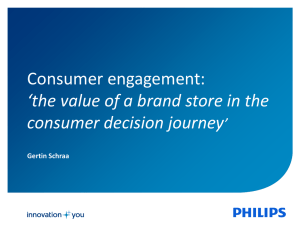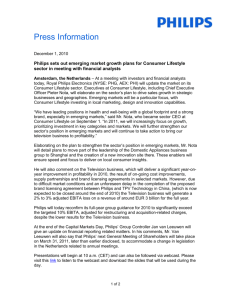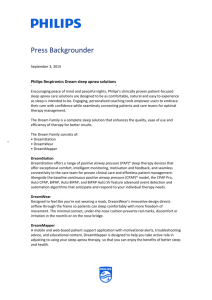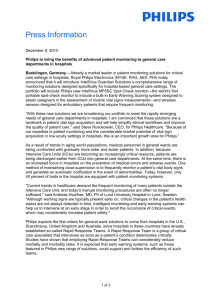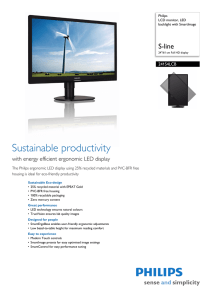Fred van Ommen Senior Vice President, Innovation Philips
advertisement
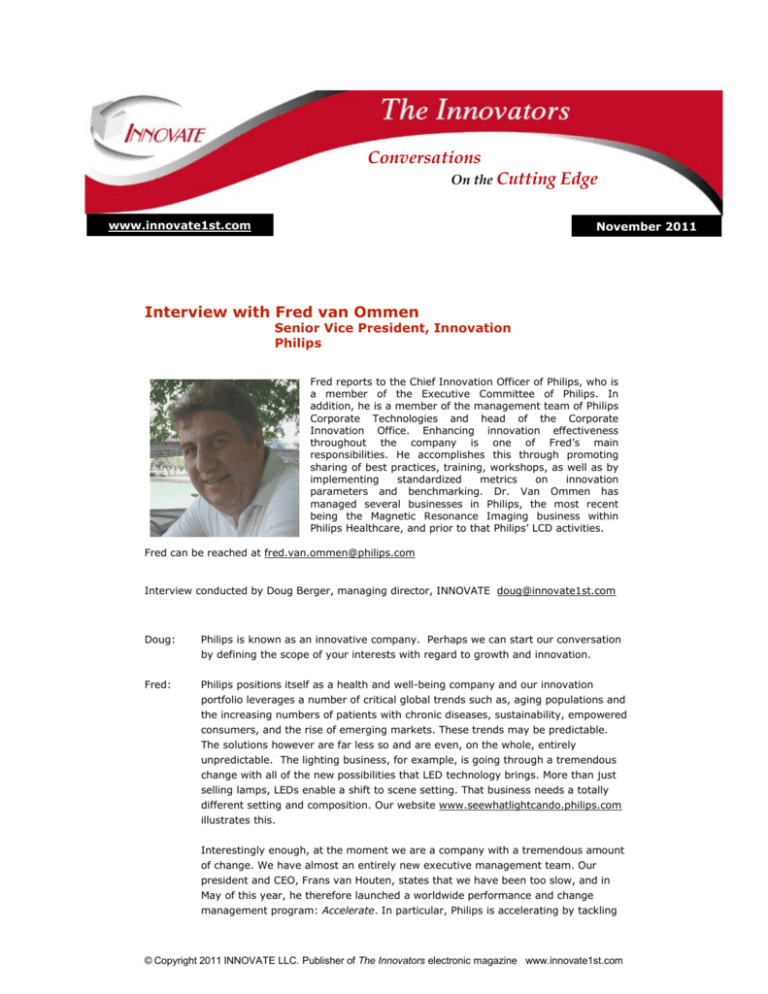
Conversations On the Cutting www.innovate1st.com Edge November 2011 Interview with Fred van Ommen Senior Vice President, Innovation Philips Fred reports to the Chief Innovation Officer of Philips, who is a member of the Executive Committee of Philips. In addition, he is a member of the management team of Philips Corporate Technologies and head of the Corporate Innovation Office. Enhancing innovation effectiveness throughout the company is one of Fred’s main responsibilities. He accomplishes this through promoting sharing of best practices, training, workshops, as well as by implementing standardized metrics on innovation parameters and benchmarking. Dr. Van Ommen has managed several businesses in Philips, the most recent being the Magnetic Resonance Imaging business within Philips Healthcare, and prior to that Philips’ LCD activities. Fred can be reached at fred.van.ommen@philips.com Interview conducted by Doug Berger, managing director, INNOVATE doug@innovate1st.com Doug: Philips is known as an innovative company. Perhaps we can start our conversation by defining the scope of your interests with regard to growth and innovation. Fred: Philips positions itself as a health and well-being company and our innovation portfolio leverages a number of critical global trends such as, aging populations and the increasing numbers of patients with chronic diseases, sustainability, empowered consumers, and the rise of emerging markets. These trends may be predictable. The solutions however are far less so and are even, on the whole, entirely unpredictable. The lighting business, for example, is going through a tremendous change with all of the new possibilities that LED technology brings. More than just selling lamps, LEDs enable a shift to scene setting. That business needs a totally different setting and composition. Our website www.seewhatlightcando.philips.com illustrates this. Interestingly enough, at the moment we are a company with a tremendous amount of change. We have almost an entirely new executive management team. Our president and CEO, Frans van Houten, states that we have been too slow, and in May of this year, he therefore launched a worldwide performance and change management program: Accelerate. In particular, Philips is accelerating by tackling © Copyright 2011 INNOVATE LLC. Publisher of The Innovators electronic magazine www.innovate1st.com problems not function-by-function, but by looking End-to-End in order to best serve the customer. This End-to-End approach consists of three core processes: Idea to Market, Market to Order, and Order to Cash/Fulfillment. Within Accelerate, I’m the global Business Process Owner of Idea to Market. With that as the high-level setting for our company, we are also looking at the structure of the company, making it simpler and leaner, to make us Fit to Grow. Doug: Within this new strategic context, what is in-scope and what is out of scope for innovation? Fred: Innovation is a successful introduction of an insightful product, service and/or solution in the market. Without payback it is just an idea. I am most interested in the end-to-end merge of trends, consumer insights, business modeling and technology into commercial success. If you think about the aging population, it's not money that is going to resolve the issue because we will simply not have enough people to take care of the elderly and the chronically diseased. What you need are new solutions. An example is our Lifeline medical alert service with automatic fall detection capabilities. Lifeline with AutoAlert features a pendant-style help button that can automatically call for help if a fall is detected and a senior is unable to push his or her help button. We will require those kinds of (technology) solutions to provide more hospital after-care and long-term care. It is a shift into solutions and services, whereby the key to success / payback is an innovative business model, i.e., the rational of how a business creates, delivers and captures value. You will need partnerships with other companies that have other competencies and capabilities to create those solutions and new business models. You cannot do it alone and you need to connect the dots. Doug: What would you describe as the mindset that you're trying to have people adopt and imbed in how they look at the business and the organization? Fred: Two keywords for me are Outside-In and Entrepreneurship. Innovation must be Outside-driven, i.e., customer-driven innovation starts and ends with the customer. One of the unique facilities that Philips Research has developed is the ExperienceLab, where we provide a natural setting in which envisioned new technologies and applications can actually be tested and experienced. In the ExperienceLab, our multi-disciplinary teams can observe people and monitor their behavior and interactions with innovative concepts. These concepts are brought to life by making use of complex - but hidden - technology or staged interactions. A simple technology push is not going to help here. An Outside-In mindset is not enough, you also need entrepreneurial people who understand business models and technology and who are able to translate customer and market insights into commercial successful propositions. There's also a geographical axis to that. If you're a traditional U.S. or European company, you think too often in the context of your local everyday life settings and extrapolate this to the growth markets or emerging markets. You need people who have been in those geographical markets and who know how to do business and understand the culture in these emerging markets. This year we rolled out a new Philips Business Management System. We want to improve our strategy execution by clear granular plans and performance transparency across 400 business-market combinations. So, we have defined a very granular approach in business market understanding, and these people have to tell 2 us what we need to do. In China, for example, they have three tiers of hospitals, which are totally different and will require different solutions and business models. Doug: How are you going about establishing this particular context within the Philips culture? Fred: Culture change is an important work stream with the Accelerate program. We will not effectively grow Philips and beat our competition unless we change our approach and mindset. We want to instill more entrepreneurial spirit in Philips and encourage teamwork and making courageous decisions. So, in July we announced new Philips Behaviors: Eager to Win, Take Ownership, and Team up to Excel. It means that we all need to ask ourselves questions like, "What can I do differently?" "What is my responsibility?" and "What can I do to make this new culture happen?" Again, the geographical angle is important as we want to empower employees to team up and to win in the markets. Doug: What else are you doing to realize this mindset and culture? Fred: Creating a common language across the company helps in realizing the new mindset. It also enables and speeds up sharing lessons learned and best practices. Another requirement is that you create transparency by using innovation metrics. In 2006, we developed at the CTO office an innovation framework to define and manage different types of innovation … granularity of innovation we called it. This Philips 4x4innovation matrix has created a common language, as well as the basis for several innovation metrics. The most significant characteristic of this matrix is the Outside-In focus: it is not Philips that is placed in the center, but the market and the customer. We look on one hand at the life-stages of the market (emerging, growing, mature, and declining) and on the other hand at the extent of the disruption for the customer. Is it perceived as a feature or a new product in an existing category (i.e. product development, Red Ocean), or is it a new adjacent category or a complete new category (i.e., new business creation, Blue Ocean)? If your business initiative is disruptive to the customers, changes in their behavior are required. Providing just the solution is not enough, and you need to develop and educate this new market segment. By understanding the type of innovation you are working on, you can use the right mode of operation, management, and performance indicators, which are different for each type of innovation. By now, other companies too, such as DSM, have introduced the 4x4 innovation matrix in their organizations. We also started several initiatives to improve the communication between the markets and research on innovation. Last year we launched an innovation portal to create better awareness in the markets on what innovations we have in our pipeline. We also indicate whether our sales organization can already share it with the market, or whether it is for information only and not to be communicated yet. By sharing earlier what we have in our innovation pipeline with our people in the field, we get much earlier feedback that still can be used during product development to improve our propositions. Doug: Companies have become competent in making organizational changes. Companies are competent in their process methodologies. I think most would agree that winning over people throughout the organization to think and act differently is a much bigger challenge than just making some organizational changes. 3 Fred: People need to understand how their business makes money. Earlier in my career I became the general manager of the LCD division, which was not doing well so I had to let go a substantial part of the employees. The key question is how one can keep the remaining people motivated. I used one slide showing: "This is what the organization costs; this is what we can produce; this is a reasonable price. If we sell so many displays, we'll break even and become profitable next." This was not a process slide but a simple business slide, which everybody could understand from the lowest ranks onwards. If you are able to create and deploy the logic of your business to your people, then at least you give people guidance in what you want to be and where you want to go. Only after that you should start new processes. If organizational changes are not driven from a business insight, there's a good chance that they will not work. Doug: I am sure that one of the big challenge areas regarding entrepreneurship has been having more rigor around business model and less early-stage rigor around process. Fred: Exactly, and this is not limited to just new business creation or venturing. If you're selling healthcare products, for example in North America or in China, the business is very different. Not only the customer requirements are different, but also the money flow (e.g., reimbursement versus paid by the patient), the go-to-market approach, quality and regulatory requirements, etc. In an early stage it is important to experiment, to fail fast and cheap. It is about thinking in alternatives, building ecosystems and co-creating with partners. The modus operandi for new business creation is about “challenge and protect” and about “living apart together” offering the venture the freedom to operate in a different way than the mother organization, but also enabling the child to leverage the capabilities and resources of the mother. We have implemented one way of working and language for managing new businesses, based on the stage-gated framework of the Bell Mason Group. We now ask different questions and have different red flags at various stages of life of the venture compared to what we were used to in the past, when we differentiated less between the different types of innovation. Implementation of this framework started at the top level of Philips, and by now more than a thousand employees have been trained. It is about learning by doing. Together with a colleague, I’m coaching, supporting and assessing these ventures within Philips. Developing and implementing a new business model is very often the key to success for these ventures. An additional advantage of incubating new ventures in your company is that you attract people with entrepreneurial behavior and a new set of capabilities and knowledge, which you will need to make the change happen in your organization. Doug: Over the period of the last six years in your current role, how has your own thinking evolved? Where have some of your beliefs changed? Fred: Many changes occurred not only externally but also within Philips. Before 2000, we were a smaller player in Healthcare and an important player in the Semiconductor Industry; now we are one of the top three players in Healthcare and we spun out Semiconductors, which is now NXP. Our ambition is leadership in health and wellbeing. As mentioned earlier, I was strengthened in my belief that successful innovation requires an Outside-In mindset. With open innovation, an increasing number of means and competencies are made available by third parties. It is no longer decisive whether a corporation itself disposes of the necessary components or 4 knowledge. Therefore the type of innovation and how I have to manage innovation is determined by the disruptiveness to customers and end-users; only after answering this question does the question of whether it is new to Philips become relevant. Understanding customer behavior and how you can change it becomes even more important than a customer insight itself. Another important insight is that you need different innovation instruments. Corporate Venturing has become a necessity as it also will help to change our company. It is not only a window to the market or future, but a mirror to our current activities. However, as my colleague says: “Large companies cherish their adults and their babies, but find it far more difficult to raise their teenagers. Without teenagers, though, there will never be new adults, who in turn are needed if the corporation is to grow and flourish.” Teenagers are innovation projects that already have progressed beyond the drawing-board stage and have started testing the first product or service of a new category in a first market segment. Viewed from the outside, they already look like adults, but their needs are really quite different – for instance, a new business model, a new distribution channel, or other prime customers. Frequently, the interests of these new nascent activities will clash with those of the established business units; as do most teenagers, they are exploring and testing their limits. Many of the things I learned over the past years are related to how to challenge and protect these ventures. Doug: You are very aware of best practices that other companies are using. You've been exposed to very different thinking from new management. What is your own wisdom about what is really going to work out? Fred: With the present rapid, technological developments it is no longer possible to do everything ourselves. And indeed, companies, research institutes, government institutions, and universities are joining their innovative powers to an increasing extent: open innovation and co-creation have become an inevitable necessity in a world in which every aspect of daily life is becoming more complex all the time. Innovation is all about ecosystems. I spend a lot of time outside my company to talk to other companies and organizations, to learn from them, to share best practices and to build networks that are key to the success of innovation. Another topic, which is high on my list, is how to create an entrepreneurial environment. I always have been triggered by the question, how can you teach entrepreneurship? What are the basic principles of entrepreneurship? Therefore, I’m inspired by the work of people like Saras Sarasvathy and Stuart Read. They revealed the five core principles that entrepreneurs use in their process of creating new ventures, products, and markets. They also showed that many of our beliefs as to why individuals are holding back from starting a new venture are misconceptions. Their method is called Effectuation. Together with my colleague Corina Kuiper, we were invited to write a chapter in the book of Thomas Blekman about Corporate Effectuations, explaining how to bring Effectuation to corporate organizations. My strong belief is that the winners of tomorrow are those companies that are able to cope with uncertainty and unpredictability; those companies that can bring the effectuation principles to life in their companies. Doug: Thank you very much Fred. Is there a final point you would like to make? Fred: Companies like Zynga and Groupon amaze me. These are companies that only exist for a few years and already have an estimated market value between $10 and $20 billion. These entrepreneurs didn’t create a huge technology breakthrough, but with partners they have been very strong in building new successful business models. I 5 am challenging people in my organization with “What’s our Zynga?” Innovation is about transformation, and as Albert Einstein already stated, “we cannot solve our problems with the same thinking we used when we created them.” Note: Fred along with colleague Corina Kuiper has recently contributed a chapter to the book, Corporate Effectuation. Click for book on Amazon.com Click to subscribe to The Innovators 6
